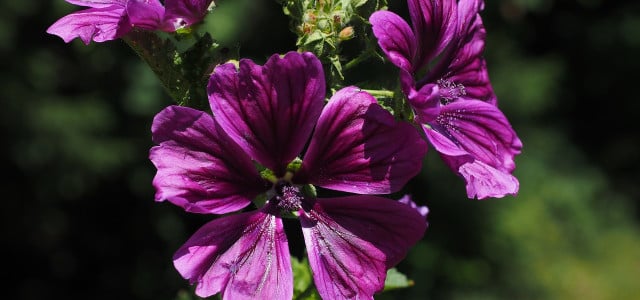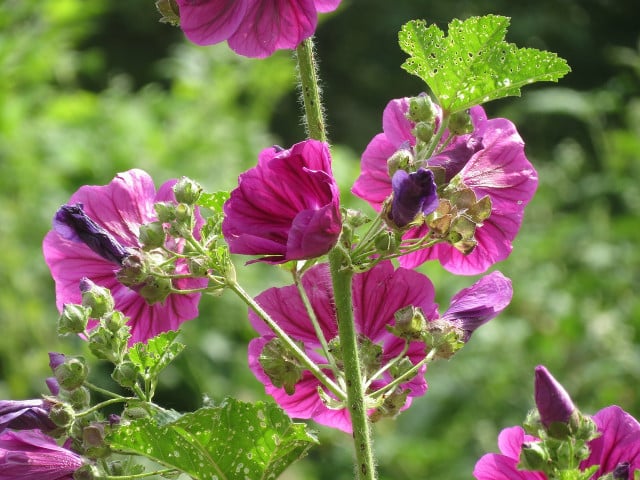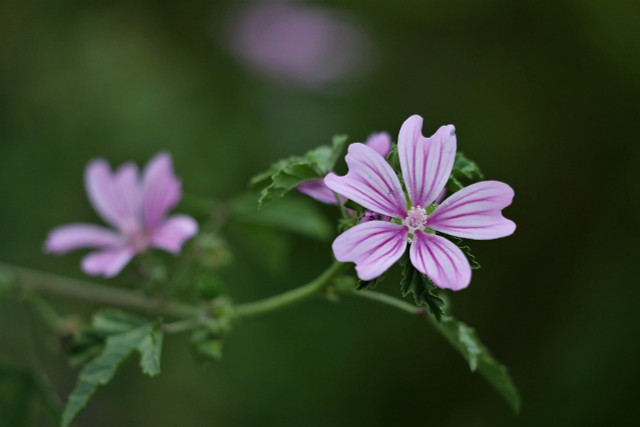
The wild mallow is not only a popular medicinal and culinary plant – with its colorful flowers it also beautifies your garden. We show you how to plant, care for and use wild mallow correctly.
The wild mallow belongs to the mallow family and originally comes from Southern Europe. Today, however, it also grows in Europe on fields and meadows. The native medicinal plant produces purple flowers that beautify your garden and provide an important food source for many insects.
Contents
How to plant wild mallow

Whether in a natural garden or a cottage garden, wild mallow feels at home in almost any environment. If you want to cultivate the plant, it’s best to use organic seeds from garden stores. You can either sow the seeds directly outdoors or grow them indoors. Please note the following tips:
- The right location: wild mallow thrives best in a sunny and wind-protected location. You can also combine it well in a perennial bed with hollyhocks or lupines. In addition, the mallow plant gets along well with various grasses, sage and catnip.
- The right soil: Wild mallow is not too demanding on the soil. It is only important that the soil is as permeable as possible so that rainwater and irrigation water can drain off properly. Otherwise, soil that is as nutrient-rich and slightly nitrogenous as possible is ideal.
- The right time: Since the wild mallow is very robust, you can sow it directly into the bed as early as autumn or March.
Sowing wild mallow directly: The wild mallow copes very well with cold temperatures. Therefore, you can plant it directly in the field in the fall.
- First clear the future site of weeds and stones.
- Scatter the seeds at a distance of five to ten centimeters and cover them lightly with soil.
- The germination period of wild mallow is two weeks. During this time, make sure that the soil is always slightly moist.
- If the young plants have formed more than three pairs of leaves, you can separate them. Dig up all the excess mallows so that there is a distance of at least 50 centimeters between the remaining plants.
- You can plant the dug up mallows in another location.
Grow wild mallow: You can also grow wild mallow seeds on a windowsill starting in February, and then plant the seedlings outdoors after two weeks.
Fill several small pots with special potting soil, which you can buy in garden stores.
Now place one seed in the center of each and cover it lightly with soil.
Place the pots in a bright spot out of direct sunlight and keep the soil slightly moist for the next two weeks.
Once the wild mallow seeds germinate, you can plant the seedlings in the garden. First remove the weeds from the bed.
Now dig several small planting holes about 50 centimeters apart.
Place the seedlings in the holes and cover them again with the dug soil. Don’t forget to water the wild mallow generously at the end.
The right care for the wild mallow

If you have planted the wild mallow in the right location, you will have little maintenance with it. With the following tips, you can make this low-maintenance plant feel permanently at home in your garden:
- Watering: During long periods of drought, you should water the wild mallow regularly so that its leaves do not dry out. Make sure, however, that no waterlogging occurs. In normal weather, the mallow plant hardly needs any additional water.
- Fertilizing: From May to August, you can feed the wild mallow with an organic fertilizer every four weeks. This will ensure that the plant continues to produce many flowers. Compost or horn shavings are best for this.
- Wintering: After the first frost, the wild mallow retreats back into its root ball and can usually withstand sub-zero temperatures of up to -23 degrees Celsius there without any problems. If you want to give the plant additional support, cut back the above-ground parts of the plant to the ground after flowering. Then cover the mallow with a layer of foliage to protect it from heavy frost.
- Propagation: Generally, wild mallow reproduces itself via its seeds. If you prefer to reseed the plant regularly, simply collect the ripe seeds from the seed pods in late summer and store them in a dark and dry place until spring. Then in the spring, you can either preplant the seeds or sow them directly.
- Pests and diseases: Wild mallow can also be affected by the so-called mallow rust. A fungal infection is responsible for this disease. As soon as you discover red pustules on the plant, you should remove the infested parts and dispose of them in the household trash. Occasionally aphids appear on the leaves of the mallow.
Tip: If you water the wild mallow with pond water, you can completely save on additional fertilizer. The water already contains many nutrients.
Use wild mallow in many ways
You can use wild mallow both in the garden and in the home. Here are some of the possibilities:
- Salads: You can use the young leaves of the mallow in salads. Pick the leaves of the young plants between June and the end of August. Then you can either add them to the salad or lightly sauté them like spinach.
- Mallow tea: The wild mallow contains many mucilages, tannins and essential oils, which make it a popular medicinal plant. In another article, we will show you how to properly prepare the popular mallow tea.
- Bouquets: The mallow plant with the purple petals is very suitable as a cut flower. The mallow also looks very decorative in a wildflower bouquet. To make them last longer, you can dry the flowers.

